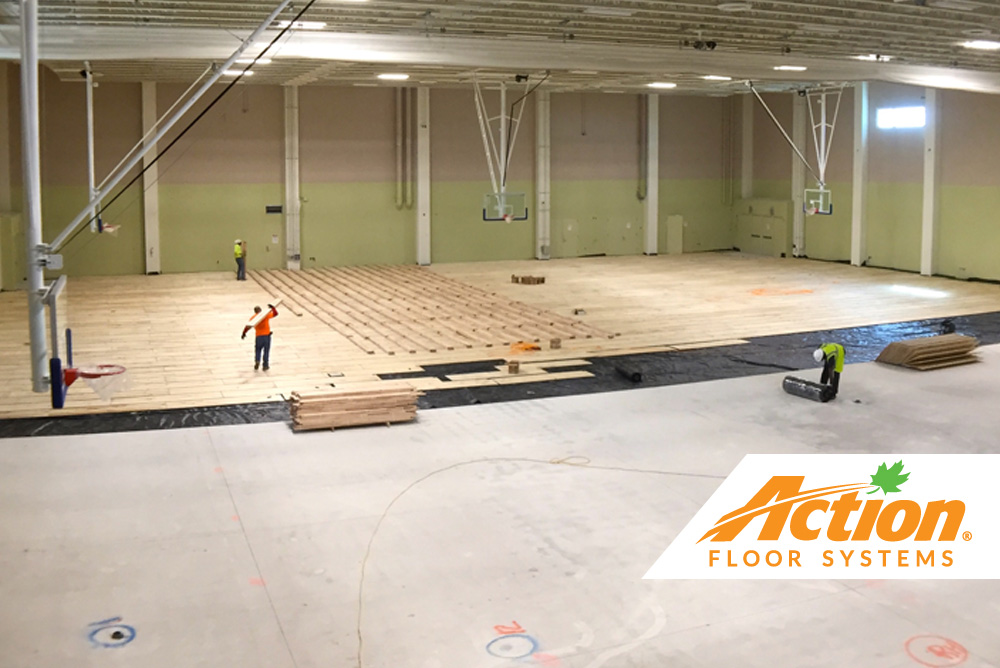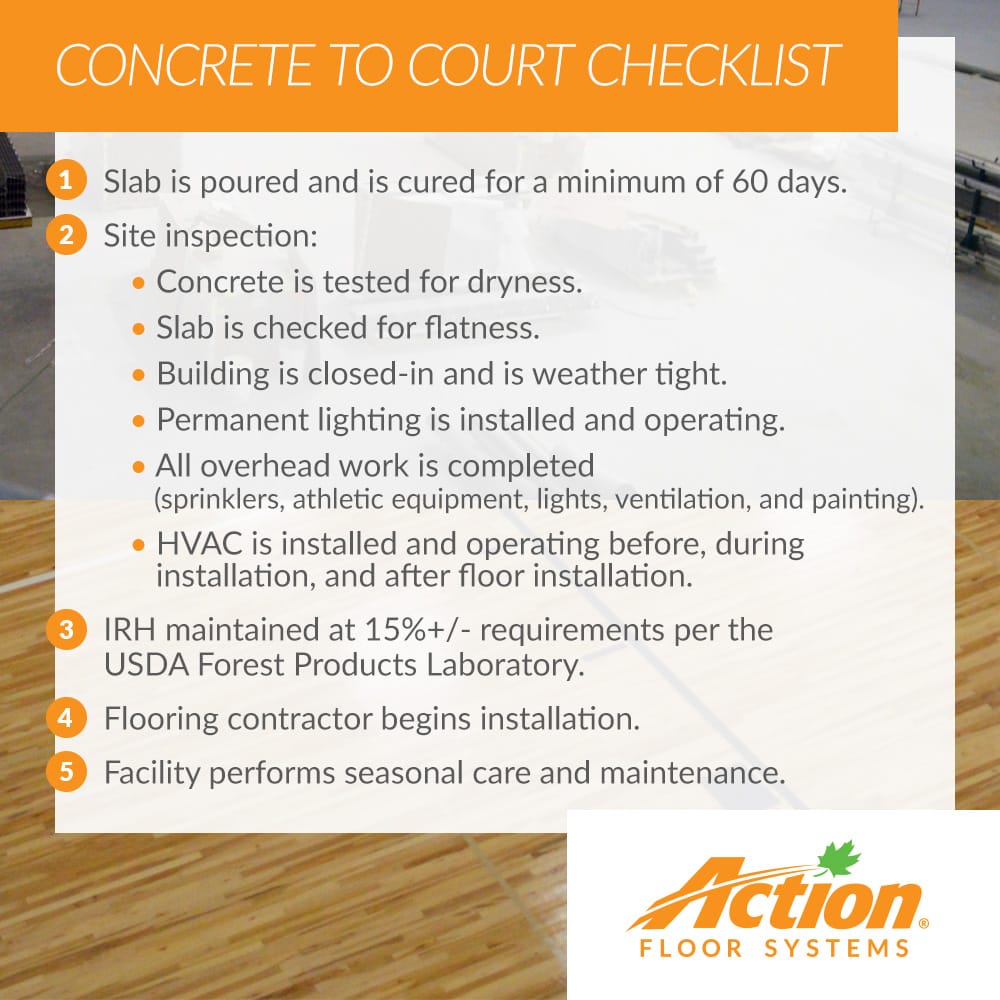
The dotted line on the contract has been signed—a new hardwood maple sports floor will soon be installed in your facility. There are a lot of moving pieces, but that doesn’t mean you should be left in the dark about the details that are about to unfold. If you’re like some of our customers, you want to know who is responsible for what and how to prepare your facility.
We spoke with Action Floors Technical Director Don Brown to learn a bit more on what it takes to prepare a facility for a hardwood sports floor installation. Brown shares insights on requirements for both the surrounding environment and the concrete underneath the floor–and what you as a facility owner should know before and during the installation.
The Concrete Slab
Whether your hardwood maple sports floor will be installed in a new building or an existing one, the condition of the concrete slab is one of the critical components to success. Before a hardwood sports floor is installed, tests will be performed to the concrete to ensure it’s dry, flat, and smooth. It is the general contractor’s responsibility to ensure all three requirements are met before the flooring materials are delivered to the facility.
Testing for dryness
To verify the concrete slab is completely dry by industry standards, there are a handful of procedures that must be followed before installation—regardless of the age of the slab. First, the slab must have been poured a minimum of 60 days prior to testing to confirm the concrete is dry and has settled. Some concrete moisture mitigation additives may be specified also, so special dryness test considerations need to be utilized. It is important to know how the concrete has been placed and specified for proper testing.
“You can’t rush concrete drying,” says Brown. “It’s the foundation of the sports floor system, and issues with it could impact performance and quality down the line.”
As a facility owner, be watchful for curing agents used to speed up the drying process. These are not recommended by Action Floors or the Maple Flooring Manufacturers Association (MFMA) and it’s possible a flooring warranty could be void if the use of a curing agent is found. Many times, this is already written into the project specifications by the architect. Nonetheless, look for an architect who will incorporate this into the flooring specifications or a general contractor who will follow these guidelines.
Once the 60 days have passed, the slab will be assessed. Falling under the ASTM F710 umbrella of preparing a concrete slab for a resilient floor, a relative humidity test (ASTM F2170) and calcium chloride test (ASTM F1869) will be performed.

Concrete slab prior to installation
According to the MFMA and accepted industry practices, the relative humidity test measures the humidity levels inside the concrete slab itself, while the calcium chloride test measures the amount of moisture passing through a concrete floor.
To perform these tests, Brown stresses the importance of using a third party—though that may not always be the most popular option because there is a cost involved. “Third parties are basically like an insurance policy,” he shares. “You have an unbiased, certified person performing the tests and providing feedback as to whether the slab meets expectations to receive a new sports floor.”
Why is this important?
“Wood flooring is moisture sensitive,” says Brown. “Moisture is a wood floor’s worst enemy.” To avoid issues with buckling, cupping, or too much expansion of the floor later, the concrete must be dry.
Checking for flatness
While there isn’t a specific ASTM test to verify a floor’s flatness, there are still ways to check for it. Action Floors’ specifications state the general contractor must provide a flat, smooth slab with a tolerance of 1/8-inch +/- in a 10-foot radius. This also aligns with the MFMA’s recommendations for concrete slab flatness.
At this point, it’s the flooring installers responsibility to double check the slab is flat prior to installation. “If there’s something wrong, it’s still the general contractor’s obligation to get it within the specifications, but it’s the flooring contractor’s duty to verify it before proceeding,” adds Brown.
Why is this important?
Brown shares that the concrete’s flatness has everything to do with the floor’s performance. “If you don’t have a concrete slab that is flat, there could be ball bounce and vibration issues, and problems can arise with bleacher operation,” he says.
Brown also shares this will likely be visibly noticeable due to the high gloss finish that’s added to seal off the floor. “In addition to the finish, the lighting in the facility will highlight the contour of the wood floor, which in turn, follows the contour of the concrete floor.”
Brown adds, “If the concrete is not flat, some unintended consequences may occur such as what the sports floor industry calls ‘dead spots,’ where you’re bouncing a basketball and the ball just feels like it’s flat and it won’t bounce back or return properly.” Although concrete flatness is always important, retained resilient floor systems greatly reduce the effects of imperfect concrete by reducing dead spots and unwanted athletic impact vibrations.
The Environment
The concrete slab is one aspect of preparing a facility for a new sports floor—the environment around it is also important.
The MFMA recommends maintaining indoor relative humidity between 35 percent and 50 percent, and shares:
“By limiting wide swings in atmospheric conditions inside the facility, you will reduce the expansion and contraction of the flooring system. If flooring materials are properly acclimated, a 15 percent fluctuation in indoor relative humidity will not adversely affect the maple. Excessive shrinkage and/or expansion may occur with indoor relative humidity variations in excess of 15 percent.”
Brown adds that the most important takeaway from MFMA’s recommendation is the 15 percent fluctuation. “Based on a facilities’ geographic location, it might not always be possible to maintain 35 to 50 percent indoor relative humidity and a temperature between 55 and 75 degrees,” he adds. “An excellent example of this would be maple floors in Arizona. It is very unlikely a facility with a maple floor in this geographical location will be able to maintain a relative humidity level between 35 to 50 percent. However, if the facility were to maintain an average high and an average low indoor relative humidity level, not separated by more than 15 percent on average for the year, they will not see excessive movement in the floor system.”
This also means proper air exchange must occur during the installation. “Action Floors requires that the HVAC system is running before any testing is done. If your HVAC system cannot be started due to warranty regulations, this conversation should be had upfront,” shares Brown. “Other avenues can be taken such as utilizing humidifiers, dehumidifiers, or fans if this is the case.”
In addition to temperature and relative humidity, all lighting, paint, and mechanical work should be completed prior to the floor installation.
Not only is it difficult to install a floor system while other trades are working in the space, but the flooring contractor needs to be able to see how the floor is going to look in proper lighting. Applying paint beforehand also protects the floor and allows the facility owner to see how the paint color impacts the final appearance as well. Additionally, things like lifts can damage the floor if they’re used to hang lighting fixtures, for example, during or after installation.
Finding the Right Partner
An experienced and proactive flooring contractor and general contractor should be able to provide you with these details throughout your journey. While the responsibilities for preparing an environment for a hardwood maple sports floor fall on others, it’s important for facility owners to be aware. Look for reputable partners that follow the right steps to ensure your investment is a lasting one. At the end of the day, you and other end users will be the ones experiencing and utilizing the facility and floor for years to come.
If you have questions about sports floor installations or would like to see recent projects that we’re proud of, view our online gallery or contact us. We’re always happy to help!



















